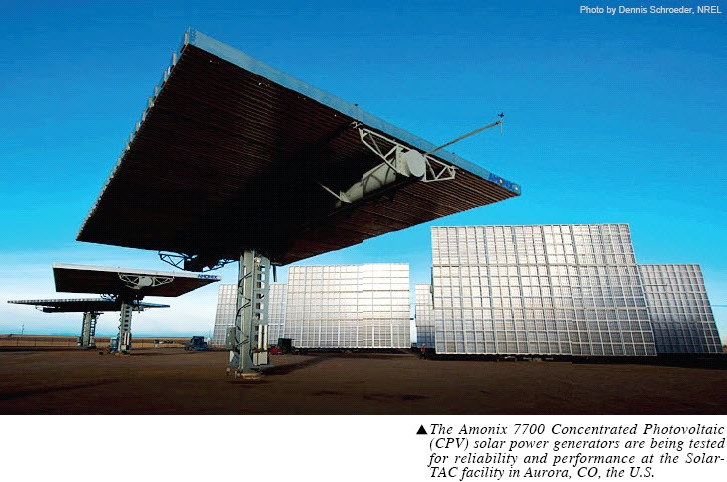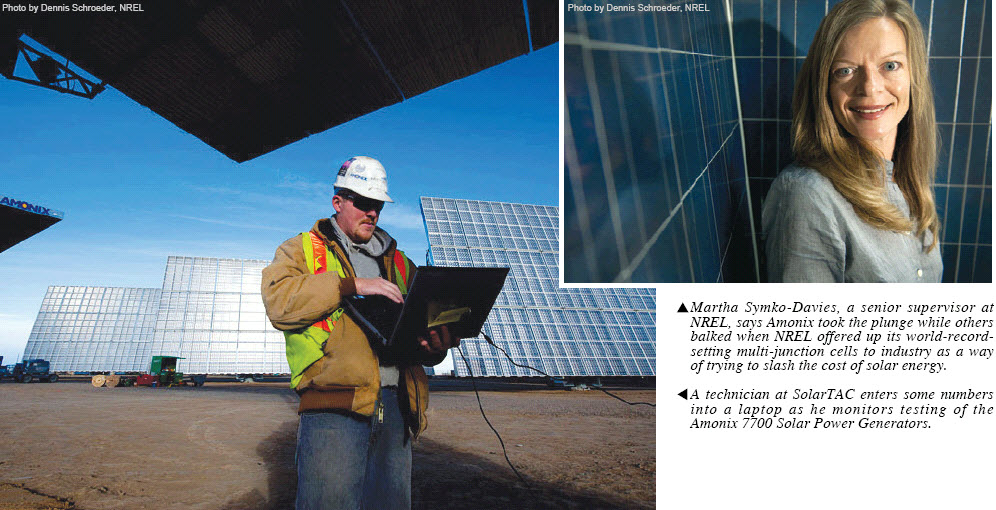By Bill Scanlon

The Amonix 7700 Concentrated Photovoltaic (CPV) Solar Power Generator, developed by Amonix and the U.S. Department of Energy’s National Renewable Energy Laboratory (NREL), is the size of an IMAX screen but costs much less than comparable generators, partly because of the efficiency of its small solar cells. It delivers more ‘energy per acre’ than anything yet available in the solar energy world.
The public-private partnership won a 2010 R&D 100 award at the annual event honoring the greatest breakthroughs in technology, often called ‘The Oscars of Invention’.
NREL’s partnerships with industry, such as this one with Amonix, are key to reaching aggressive White House goals including lowering solar energy’s installed cost to US$1 a watt, which would make America a leader in renewable energy.
The 7700 uses acrylic Fresnel lenses to concentrate sunlight up to 500 times its usual intensity and direct it onto 7,560 tiny, highly efficient multi-junction PV cells.
The cells, originally developed by NREL scientists, can convert 41.6% of the sunlight that shines on them into usable electricity in a laboratory setting, a world record. Production cells never work quite as well as cells produced in the lab. But the multi-junction cells on the Amonix 7700 are achieving 31% efficiency at the module level and 27% at the system level in the field, the highest ever achieved for an operating CPV concentrator.
That unprecedented efficiency opened the door to reducing costs and reducing land use--both key for solar electricity to reach cost-parity with fossil fuels.
Seeing the potential for game-changing cost cuts, Amonix, with technical support from NREL’s High-Performance PV Project and financial support through DOE and its Solar Energy Technologies Program, redeveloped its flagship CPV system using the multi-junction cells.
A six-inch square silicon wafer in traditional Photovoltaic (PV) panels produces about 2.5 watts of electricity. That same-sized wafer, cut into hundreds of square-centimeter cells in the Amonix 7700, each teamed with a Fresnel lens, produces more than 1,500 watts. It reduces the required area for cells 500 times.
The 7700 already has driven the price of electricity from solar down to the price of electricity from natural gas, according to the California Market Price Referent, which establishes a proxy price for electricity generated by a new state-of-the-art natural gas plant. Solar power is at or near price parity in six other states that share California’s sunny and dry climates--Arizona, Nevada, Utah, New Mexico, Colorado and Texas.
The 7700 also keeps down costs by integrating the lenses, the cells and the mounting structure into a single unit that eliminates most of the parts and costs associated with other concentrator designs. The seven MegaModules that make up the 53-kilowatt system can be hauled on two flatbed trucks, then assembled in the field in hours, rather than weeks.
Low-Cost, Efficiency Attract Interest from Utilities
Those cost-slashing measures, together with the Amonix 7700’s large-scale capacity, are catching the interest of utility companies from California to Colorado. Twenty Amonix 7700s, erected on just five acres of desert, can generate more than a megawatt of rated capacity, enough to power 750 homes. That’s half the space typically needed to generate that much power.
The Southern Nevada Water Authority and California Polytechnic Institute in California are among those that have purchased the Amonix 7700. The DOE and Amonix are paying for testing of the 7700 at the Solar Technology Acceleration Center (SolarTAC) in Aurora, Colo., to validate the reliability of the system.
Multi-Junction Cells Key to Record-Setting Efficiency
The key breakthrough that lifted the 7700 to a 50% greater power output than previous generations of Amonix generators was the substitution of the multi-junction cells made of gallium indium arsenide and gallium phosphide for the more common silicon cells.
Cells made from gallium, indium and other elements from the III and V columns of the periodic table are more expensive to produce today, but also can be more efficient at converting the sun’s photons into usable electrons for electricity.
NREL scientists had developed a high-efficiency multi-junction indium gallium phosphide PV cell that had been used previously for energy for spacecraft.
DOE, NREL High-Performance PV Project Funded Breakthrough
To offer up the more efficient multi-junction cell as a possible replacement for the silicon cells used in most PV concentrators, NREL issued a request for proposals for projects designed to accelerate multi-junction cell development and their integration into CPV solar systems. NREL awarded Amonix US$1.2 million for a project that began in 2004 and concluded in 2008. At the end of the NREL project, Amonix was able to demonstrate close to 31% efficiency for a one-square-meter module a world record at the time.

Martha Symko-Davies, a senior supervisor at NREL, recalled that most concentrator companies could not see the benefits of switching to new-generation solar cells, but Amonix was different, conducting research and development with NREL to overcome stiff challenges.
The first NREL/Amonix project led to a larger award in 2007 from DOE for US$15.6 million leveraged by an additional US$18 million of investor funds, which helped make the transition to manufacturing of the Amonix 7700 at the company’s facility in Seal Beach, Calif.
Amonix has 15 years of experience developing CPV systems, while NREL has a record of more than three decades of research and development in PV technologies. The fruitful partnership, incoroporating the high-efficiency multi-junction solar cell with Amonix’s flagship CPV system, came about through the High-Performance PV Project funded by the DOE’s Solar Energy Technologies Program.
Other DOE-funded support came from the Small Business Innovation Research and Technology Pathway Partnership programs. DOE’s Sandia National Laboratories and Brookhaven National Laboratory also facilitated the scale-up of this project.
A conundrum was how to use the highly efficient cells without breaking the bank. Researchers solved that problem by teaming an inexpensive Fresnel lens--at less than US$2 a pop--with each of the 7,560 high efficiency solar cells that make up one 53-kilowatt 7700 system. The 500-power amplification of the Fresnel lens allowed the solar cells to be tiny--thus a small fraction of the cost of bigger cells--while still packing record-setting efficiency.There were other hurdles to clear, too.
Researchers developed a new receiver package of cells and lenses to ensure that the cells would not short out. They solved the distortion problem that happens when a lens doesn’t focus all colors on the same convergence point. And they overcame the thermal issues that crop up when a cell has to handle the intensity of 500 suns.
Their efforts were rewarded in the form of US$130 million in private equity financing in 2010.
Expanding the Market to Everyone
Solar energy has found a niche on rooftops, especially of green-minded homeowners. But if it is to play a major role in the broader electricity market, it needs to come in at or below the costs of electricity generated from coal, which is projected to cost from 6 cents to 15 cents per kilowatt-hour in four years. The 7700’s cost per kilowatt-hour is expected to be well within those price ranges as production and sales continue to grow.
“This development and R&D investment enabled the entire CPV industry,” Symko-Davies said. “This could truly shake up the world and add competition to the flat-plate technologies being deployed at utility scale.” The 7700’s two-axis tracker can be repositioned throughout the day to follow the sun, but also can be re-positioned to shield the cells from extreme wind, increasing the life of the system. It allows the cells to capture sunlight for a longer time throughout the day and through all seasons of the year. Field tests indicate that depending on the location, the two-axis tracker captures up to 50% more energy than fixed one-axis systems.
Utilities expect their generators to last 50 years. The Amonix 7700 can reach that target with proper maintenance and timely replacement of certain parts, said a spokesman for the company.
Two Axis-Tracker, Modular Design Key to Cost Savings
The two-axis tracker is the only moving component on Amonix’s CPV systems and has been designed for reliability and minimum maintenance. The energy needed to move the two-axis tracker amounts to less than 1% of the power output.
The system has just 12 subassemblies, which are shipped to installation sites for deployment. Once the site is ready, an Amonix system can be installed very quickly, within hours. By contrast, some systems require shipment of thousands of parts to the installation site.
Cost savings were factored in every step of the way--from foundry to grid--said Bob McConnell, who worked at NREL before he left the lab in 2007 to join Amonix and help bring the research to market.
The result is a generator manufactured at about a third to one half of generators using crystalline silicon or thin-film approaches.
Multi-junction cells can operate at higher ambient temperatures than traditional PV cells, making them ideal for sunny and dry climates in the southwestern United States, and ripe for future cost reductions.
The concentrator also is kinder to the environment than most large systems, using no water in its operation. Propped up two feet above the land, it doesn’t hinder the movement of wildlife.
“You simply can’t put enough solar systems on rooftops to achieve the scale and capacity necessary to generate electricity in the quantities required by utilities and by society,” said Amonix’s founder and chief technical officer, Vahan Garboushian. “This is a technology that can meet the terawatt (trillions of watts) needs of the world for clean electricity.”
Bill Scanlon is a writer for National Renewable Energy Laboratory (NREL)’s Public Affairs office (www.nrel.gov). He is the former science writer of the Rocky Mountain News.
For more information, please send your e-mails to pved@infothe.com.
ⓒ2011 www.interpv.net All rights reserved. |



